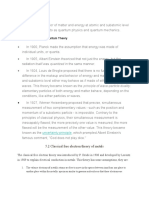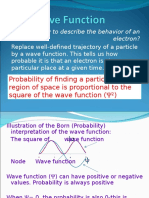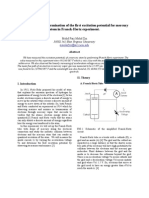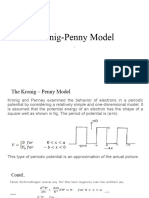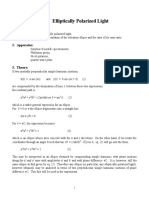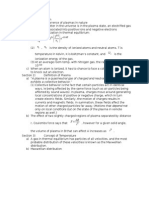Part 1 Solid State, Defects, Diffraction
Part 1 Solid State, Defects, Diffraction
Uploaded by
Dan Jeric Arcega RustiaCopyright:
Available Formats
Part 1 Solid State, Defects, Diffraction
Part 1 Solid State, Defects, Diffraction
Uploaded by
Dan Jeric Arcega RustiaOriginal Description:
Copyright
Available Formats
Share this document
Did you find this document useful?
Is this content inappropriate?
Copyright:
Available Formats
Part 1 Solid State, Defects, Diffraction
Part 1 Solid State, Defects, Diffraction
Uploaded by
Dan Jeric Arcega RustiaCopyright:
Available Formats
Solid State Physics
Branch of condensed matter physics dealing with properties of solids especially crystals
Atomic packing factor:
Classifications of solids: 1. Crystals 2. Amorphous
Counting for some unit cells: Vertex = 1/8 atom Edge = atom Face = atom Body = 1 atom 1. Simple Cubic Structure (SC) - Close packed directions are cube edges - Coordination # = 6 (# of nearest neighbors) - # of atoms: = (1/8*8) = 2
Descriptions of over-all structure: 1. Lattice - Regular arrangement of mathematical points in 3D described by the unit of repetition of the crystal - Lattice constant distance between two lattice points 2. Basis - The arrangement of atoms at each lattice point - Could range from atom to large molecules 3. Unit cell - Three dimensional cell constructed from adjacent lattice points that best describes the crystal structure - Building block of a crystalline structure - Repeats itself to form the lattice
2. Body Centered Cubic Structure (BCC) - Closed pack directions are cube diagonals - Coordination # = 8 - # of atoms = (1/8*8 + 1) = 2
Metallic Crystals - Tend to be densely packed - Made of heavy elements - Bonding is not directional - Neighbor distances tend to be small in order to lower bond energy
Examples: 1: Using the hard sphere model, find the length a of the unit BCC cell. Assume radius of the atom is R.
2. Determine the maximum radius of the sphere B which can be placed into a BCC structure without affecting the position of the other spheres. (Ans: 0.155A)
2. Determine the maximum radius of the sphere B which can be placed into an FCC structure without affecting the position of the other spheres. Assume the radii of sphere A is A and radius of B is B. (Ans: 0.41A)
3. Determine the actual volume occupied by the spheres in an BCC structure as % of total volume. This is called packing density or atomic packing factor. (Ans: 0.68). Find also the coordination number .(8)
3. Determine the actual volume occupied by the spheres in an FCC structure as % of total volume. This is called packing density or atomic packing factor. (Ans: 0.74)
3. Face centered cubic structure (FCC) - Close packed directions are face diagonals - Coordination # = 12 - # of atoms = (1/8*8 + 1/2*4 + 1) = 4
4. Hexagonal closed packed - Formed by two hexagons and one atom at the center of the hexagons - The hexagons are separated by three atoms fitting into the sites - # of atoms = 6 - Coordination # = 12
A site
B site
A site
1: Using the hard sphere model, find the length a of the unit cell of an FCC structure. Assume radius of the atom is R.
Theoretical density:
- atom is transferred from a lattice site to an interstitial position
n = number of atoms/unit cell Vc = volume/unit cell (cm^3/unit cell) A = atomic weight (g/mol) Na = Avogadros number (6.023x10^23 atoms/mol) Example 1: Compute the theoretical density of copper based on the following information.
n = number of vacancies N = total number of atoms Ev = enthalpy of formation T = temp in K Kb = Boltzmann Constant (1.38x10^-23 J/atomK OR 8.62x10^-5eV/atomK) Example: Suppose that the energy required to remove a sodium atom from the inside of a sodium crystal to the boundary is 1 eV. Calculate the concentration of Schottky vacancies at 300K.
Crystal structures: Polymorphism - Same compound occurring in more than one crystal (example: silica) Allotropy - Polymorphism in elemental solids (e.g. carbon) Defects A. Point defects 1. Vacancy unoccupied lattice point 2. Interstitial extra atom not in regular lattice position 3. Substitutional occupancy of a lattice point by impurity 4. Antisite a host atom occupies position of another host atom Types of vacancy: 1.A. Schottky Defect - an atom transfers from a lattice site in the interior to a lattice site on the surface of a crystal 1.B. Frenkel Defect
Schottky defect in ionic crystals:
Frenkel defect:
B. Line defects - dislocations 1. Edge dislocation an extra plane of atoms squeezed into a part of the crystal lattice 2. Screw dislocation a step or ramp is formed by the displacement of the atoms in a plane in the crystal 3. Stacking fault a change in the stacking sequence over a few atomic spacings 4. Twin region a change over many atomic spacings
1. Grain boundary separate regions of different crystalline orientation 2. Tilt boundary array of edge dislocations 3. Twin boundary mirror of each other C. Volume defects 1. Void 1.A Porosity air bubbles trapped 1.B Cavitation shrinkage of a material 1.C Precipitates impurity atoms cluster together to form small regions of a different phase Diffraction Bragg equation:
d = interplanar spacing d= sqrt(h^2+k^2+l^2)
You might also like
- Models - Plasma.drift Diffusion TutorialDocument14 pagesModels - Plasma.drift Diffusion TutorialbkmmizanNo ratings yet
- Quantum TheoryDocument3 pagesQuantum TheoryRitu Raj Lamsal100% (1)
- Richardson EqnDocument3 pagesRichardson Eqnagnirailways100% (1)
- Fronius Auto Argon-Arc WeldingDocument26 pagesFronius Auto Argon-Arc WeldingarcenergyNo ratings yet
- Theories of Ore GenesisDocument10 pagesTheories of Ore GenesisIrwan EPNo ratings yet
- Analysis of Circuits Containing Ideal Op AmpDocument12 pagesAnalysis of Circuits Containing Ideal Op Ampbbwx4114No ratings yet
- Ex8Serie1 - Gamow's Theory of Alpha Decay (1) - 1 MileDocument6 pagesEx8Serie1 - Gamow's Theory of Alpha Decay (1) - 1 Milekrlekrle123No ratings yet
- Lecture 4 Wavefunction NewDocument53 pagesLecture 4 Wavefunction NewkedirNo ratings yet
- Atomic and Molecular Spectroscopy Lecture 2Document29 pagesAtomic and Molecular Spectroscopy Lecture 2Hammed LawalNo ratings yet
- General Properties of Nuclei - IDocument6 pagesGeneral Properties of Nuclei - IAaush PradhanNo ratings yet
- Physics Module 4 Question Bank 2018 19Document2 pagesPhysics Module 4 Question Bank 2018 19Aman DesaiNo ratings yet
- Schrodinger EquationDocument36 pagesSchrodinger EquationTran SonNo ratings yet
- Del OperatorDocument6 pagesDel OperatorSupriya Aggarwal100% (1)
- Sample Questions On Polarization of LightDocument3 pagesSample Questions On Polarization of Lightssmukherjee2013No ratings yet
- Determination of The First Excitation Potential For Mercury Atom in Franck-Hertz Experiment.Document5 pagesDetermination of The First Excitation Potential For Mercury Atom in Franck-Hertz Experiment.Faiz Zin100% (3)
- Optoelectronic Materials and DevicesDocument16 pagesOptoelectronic Materials and DevicesMar'i MuchammadNo ratings yet
- Optoelectronics SyllabusDocument4 pagesOptoelectronics SyllabusabdulbabulNo ratings yet
- Michelson PHYWE PDFDocument2 pagesMichelson PHYWE PDFLorran Neves100% (2)
- Plasma ConfinementDocument3 pagesPlasma ConfinementSunny KumarNo ratings yet
- L2. Structure of MatterDocument11 pagesL2. Structure of MatterNourhan IbrahimNo ratings yet
- Kronig-Penny ModelDocument12 pagesKronig-Penny ModelArighna BasakNo ratings yet
- IO.5 Elliptically Polarized Light: 1. PurposeDocument5 pagesIO.5 Elliptically Polarized Light: 1. PurposeAaloka GautamaNo ratings yet
- Moments and Products of Inertia, Inertia TensorDocument4 pagesMoments and Products of Inertia, Inertia TensorAbhijit Kar Gupta100% (1)
- Physics Tut Sheet 3 Dielectric PropertiesDocument2 pagesPhysics Tut Sheet 3 Dielectric PropertiesHarshit SoniNo ratings yet
- Chem 11 Unit 7 PPT 1 HebdenDocument27 pagesChem 11 Unit 7 PPT 1 HebdenMarina XuNo ratings yet
- PDF 9 Questions Amp Answers On Maxwell Equations DDDocument39 pagesPDF 9 Questions Amp Answers On Maxwell Equations DDKhanapuram Uday KumarNo ratings yet
- CHM 101 - Faraday's Laws of ElectrolysisDocument14 pagesCHM 101 - Faraday's Laws of ElectrolysisHaneef Ayinde100% (1)
- Introduction To Plasma Physics and Controlled Fusion Notes For Journal 1Document18 pagesIntroduction To Plasma Physics and Controlled Fusion Notes For Journal 1api-272993678100% (1)
- (#3) Direct, Indirect, Ek Diagram, Effective Mass-1Document6 pages(#3) Direct, Indirect, Ek Diagram, Effective Mass-1zubairNo ratings yet
- 2.1 The Structure of SolidsDocument22 pages2.1 The Structure of Solidsashleykingpalomo13No ratings yet
- Electron Theory of SolidsDocument18 pagesElectron Theory of SolidsJoyita100% (1)
- EEN2056 Tutorial 2Document2 pagesEEN2056 Tutorial 2Paramesvaran Veerasingam100% (1)
- A Review of Magneto-Optic Effects and Its Application: Taskeya HaiderDocument8 pagesA Review of Magneto-Optic Effects and Its Application: Taskeya HaiderkanchankonwarNo ratings yet
- Chapter2 Introduction To Quantum MechanicsDocument32 pagesChapter2 Introduction To Quantum MechanicsTahsin MorshedNo ratings yet
- 14a Plancks Constant Photo Electric EffectDocument7 pages14a Plancks Constant Photo Electric EffectSAKSHI SINGHNo ratings yet
- 6.EMT Question Papers.Document2 pages6.EMT Question Papers.Praveen RajkumarNo ratings yet
- Fermi EnergyDocument7 pagesFermi EnergyBobNo ratings yet
- EC6411 Circuit & Devices Lab ManualDocument93 pagesEC6411 Circuit & Devices Lab ManualKALAIMATHINo ratings yet
- Dielectric Properties of SolidsDocument4 pagesDielectric Properties of SolidsNisaNurpertiwiNo ratings yet
- Ramsauer-Townsend Effect PDFDocument3 pagesRamsauer-Townsend Effect PDFmisanthropoNo ratings yet
- Very Short Answer Type Questions - Physics - Units & MeasurementsDocument10 pagesVery Short Answer Type Questions - Physics - Units & Measurementshari95No ratings yet
- Question Bank - BS-PH201 - 2019 (New Syllabus)Document23 pagesQuestion Bank - BS-PH201 - 2019 (New Syllabus)SUDIPTA SADHUKHANNo ratings yet
- Kronig-Penney Model: Explained by Dr. Vishnu AwasthiDocument8 pagesKronig-Penney Model: Explained by Dr. Vishnu AwasthiDikshant patialNo ratings yet
- Old Engineering Physics Question PaperDocument1 pageOld Engineering Physics Question PaperHithes PathiyilNo ratings yet
- Kronig-Penny Model - Matlab CodeDocument6 pagesKronig-Penny Model - Matlab CodeJay Stinson Kalinani67% (3)
- Electrical Properties of Semiconductors PDFDocument2 pagesElectrical Properties of Semiconductors PDFApril Wilson100% (1)
- Chapter 38Document14 pagesChapter 38Obaid0% (1)
- Interatomic Forces: What Kind of Force Holds The Atoms Together in A Solid?Document36 pagesInteratomic Forces: What Kind of Force Holds The Atoms Together in A Solid?aditya_2013No ratings yet
- Crystal SymmetryDocument10 pagesCrystal SymmetryManozer Mensah100% (1)
- Electromagnetic Theory Question Bank Semester-III StudyhauntersDocument8 pagesElectromagnetic Theory Question Bank Semester-III StudyhauntersSriram JNo ratings yet
- Engineering Physics Jan 2014Document3 pagesEngineering Physics Jan 2014Prasad C MNo ratings yet
- Phonons I. Crystal Vibrations yDocument39 pagesPhonons I. Crystal Vibrations yArtur Dresel100% (1)
- CDS SpectrometerDocument8 pagesCDS Spectrometerashmita100% (1)
- CathodoluminescenceDocument336 pagesCathodoluminescenceJosé RamírezNo ratings yet
- The Reciprocal LatticeDocument7 pagesThe Reciprocal LatticeCristina Bran100% (1)
- Bonding Forces and EnergiesDocument3 pagesBonding Forces and EnergiesJaden BrownNo ratings yet
- Experiment 5 Title: Acceleration of Free Fall by Means of The Simple Pendulum. ObjectiveDocument2 pagesExperiment 5 Title: Acceleration of Free Fall by Means of The Simple Pendulum. ObjectiveReam MairNo ratings yet
- 16 - Central Force Motion PDFDocument21 pages16 - Central Force Motion PDFUltrazordNo ratings yet
- Aieee-2012 Physics SolutionsDocument5 pagesAieee-2012 Physics SolutionsAman Bhutta100% (1)
- Formation of Onion-Like NiCo2S4 Particles via Sequential - 單操報告Document13 pagesFormation of Onion-Like NiCo2S4 Particles via Sequential - 單操報告Dan Jeric Arcega RustiaNo ratings yet
- MGV (Marshall Guv'nor Replica) : TM TMDocument1 pageMGV (Marshall Guv'nor Replica) : TM TMDan Jeric Arcega RustiaNo ratings yet
- Fast Recovery Diodes & Schottky DiodesDocument3 pagesFast Recovery Diodes & Schottky DiodesDan Jeric Arcega Rustia0% (1)
- Capacitor TagsDocument1 pageCapacitor TagsCalin AcroitoriteiNo ratings yet
- Transistor KSP-2222A-NPN PDFDocument3 pagesTransistor KSP-2222A-NPN PDFemanr zNo ratings yet
- IcsDocument45 pagesIcsDan Jeric Arcega RustiaNo ratings yet
- ICs PDFDocument45 pagesICs PDFDan Jeric Arcega RustiaNo ratings yet
- IGBT, FETMOSFETSaDocument7 pagesIGBT, FETMOSFETSaDan Jeric Arcega RustiaNo ratings yet
- TransistorsDocument7 pagesTransistorsDan Jeric Arcega RustiaNo ratings yet
- PrintDocument2 pagesPrintAnnie SabrieNo ratings yet
- Processing Cheat SheetDocument1 pageProcessing Cheat SheetDan Jeric Arcega RustiaNo ratings yet
- Band Theory of SolidsnvnvbDocument28 pagesBand Theory of SolidsnvnvbDan Jeric Arcega RustiaNo ratings yet
- Partners and Marriage - 12Document4 pagesPartners and Marriage - 12Dan Jeric Arcega RustiaNo ratings yet
- GSM CodesDocument3 pagesGSM CodesDan Jeric Arcega RustiaNo ratings yet
- Land Title 0002Document1 pageLand Title 0002Dan Jeric Arcega Rustia100% (1)
- Digital Logic Gates: ECE Department Faculty of Engineering University of Santo TomasDocument16 pagesDigital Logic Gates: ECE Department Faculty of Engineering University of Santo TomasDan Jeric Arcega RustiaNo ratings yet
- OP-AMP Open Loop ConfigurationDocument8 pagesOP-AMP Open Loop ConfigurationDan Jeric Arcega RustiaNo ratings yet
- Sched PDFDocument1 pageSched PDFDan Jeric Arcega RustiaNo ratings yet
- Selection of Spot Welding ElectrodesDocument2 pagesSelection of Spot Welding ElectrodesalenturskiNo ratings yet
- Mec281: Materials Science: Phase DiagramDocument74 pagesMec281: Materials Science: Phase Diagrampatel ketan100% (1)
- Pss 10 13.1 eDocument2 pagesPss 10 13.1 ecandratrikusumaNo ratings yet
- Jte10988j DL.1207477 1Document6 pagesJte10988j DL.1207477 1Tatiane ChuvasNo ratings yet
- Phase Diagram SiO2Document4 pagesPhase Diagram SiO2Mary Galvez Vazquez50% (2)
- Extraction of MetalsDocument55 pagesExtraction of MetalsCatriona Chaikin100% (1)
- Sigma Phase Charectaristaion in AISI 316 SSDocument2 pagesSigma Phase Charectaristaion in AISI 316 SSAlMawali76No ratings yet
- AnchorDocument5 pagesAnchorpadalakirankumarNo ratings yet
- All AWS - CodesDocument11 pagesAll AWS - CodesPradip Tapan Banerjee100% (1)
- Fractography AluminiumDocument21 pagesFractography AluminiumFazry NurokhmanNo ratings yet
- Metals QuestionsDocument28 pagesMetals QuestionsG M Ali KawsarNo ratings yet
- Tri State Mining District: OverviewDocument10 pagesTri State Mining District: OverviewChristopher WisemanNo ratings yet
- Sampling of Precious MetalsDocument4 pagesSampling of Precious MetalsBadar HayatNo ratings yet
- Industrial Project Report (WPS)Document79 pagesIndustrial Project Report (WPS)Khairil Anwar MuhajirNo ratings yet
- Spu BookDocument121 pagesSpu BookAngga Aprian DinataNo ratings yet
- TP Stainless Steel Pipes - CatalogueDocument24 pagesTP Stainless Steel Pipes - CatalogueVivek BhartiNo ratings yet
- General SpecficationsDocument6 pagesGeneral SpecficationsesooNo ratings yet
- 7 Forms of Corrosion IDocument39 pages7 Forms of Corrosion IJesus De la RosaNo ratings yet
- Silicon Carbide Synthesis and ProcessingDocument17 pagesSilicon Carbide Synthesis and ProcessingJoao LuisNo ratings yet
- Survey Welding-Standards 13-09-2010Document1 pageSurvey Welding-Standards 13-09-2010Nenad MilosevicNo ratings yet
- Aalco Metals LTD Aluminium Alloy 5251 H22 Sheet and Plate 150Document2 pagesAalco Metals LTD Aluminium Alloy 5251 H22 Sheet and Plate 150Anish Mangalathu MohananNo ratings yet
- Multiple Choice 2 Heat Treatment Carbon Content PreheatDocument10 pagesMultiple Choice 2 Heat Treatment Carbon Content PreheatAhmed Ben Nouma100% (1)
- 17-4 PH Bar Data SheetDocument2 pages17-4 PH Bar Data SheetBryan KellyNo ratings yet
- Tantalum Niobium EtchantsDocument2 pagesTantalum Niobium EtchantsmitgraNo ratings yet
- 2 Ceramics - WhitewaresDocument5 pages2 Ceramics - WhitewaresTristan James Sim100% (1)
- Alloy Steels 8620: Chemistry DataDocument6 pagesAlloy Steels 8620: Chemistry DataVijay PalNo ratings yet
- Engi 4032FB03 (Midtermanswers)Document6 pagesEngi 4032FB03 (Midtermanswers)tekellamerZ aka tekellamerNo ratings yet

